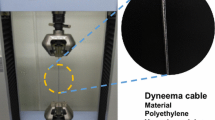Abstract
The polymer cable is a widely used material in the cable-driven parallel robot (CDPR) system because of its many advantages such as high sensitivity, large workspace and so on. However, the accurate control of CDPR is not easy because of complicated response of the cable. In our previous study, the integrated cable model was derived. Based on the model, parametric studies were progressed in this paper. While operating CDPR, various parameters such as length, applied tension, and tensile rate can be changed and dominantly affect the dynamics of CDPR. For this reason, parametric study was based on these parameters. In this investigation, dynamic creep, hardening factor and short-term recovery were saturated as processing cyclic load. Each saturation rate was dominantly influenced by cable length and applied tension. As the tensile rate was increased, the dynamic creep was decreased. The hysteresis was the characteristic combining all of dynamics. So, the hysteresis also had saturation trends. When the exerted tension was decreased, the length of cable could be reduced or elongated because the creep and recovery occur at the same time.









Similar content being viewed by others
References
R. Dekker, A. Khajepour, S. Behzadipour, Design and testing of an ultra-high-speed cable robot. Int. J. Robot. Autom. 21, 25–34 (2006)
P. Miermeister, A. Poot, A. Verl, Dynamic modeling and hard-ware-in-the loop simulation for the cable-driven parallel robot IPAnema. International symposium on robotics, pp. 1288–1295 (2010)
R. Chattopadhyay, Textile rope—a review. Indian J. Fibre Text. Res. 11, 360–368 (1997)
M. Miyasaka, M aghighipanah, Y. Li, Hysteresis model of longitudinally loaded cable for cable driven robots and Identification of the parameters. IEEE International conference on robotics and automation (ICRA), pp. 4015–4057 (2016)
V. Schmidt, A. Pott, Increase of Position Accuracy for Cable-Driven Parallel Robots Using a Model for Elongation of Plastic Fiber Ropes, in New Trends in Mechanism and Machine Science, ed. by P. Wenger, P. Flores (Mechanisms and Machine Science, Springer, Cham, 2017), pp. 335–343
S.H. Choi, K.S. Park, Integrated and nonlinear dynamic model of a polymer cable for low-speed cable-driven parallel robots. Microsyst. Technol. 24(11), 4677–4687 (2018)
J.M. Heo, S.H. Choi, K.S. Park, Workspace analysis of a 6-DOF cable-driven parallel robot considering pulley bearing friction under ultra-high acceleration. Microsyst. Technol. 23(7), 2615–2627 (2017)
S. Kawamura, W. Choe, S. Tanaka, S.R. Pandian, Development of an ultrahigh speed robot FALCON using parallel wire drive systems. J. Robot. Soc. Jpn. 15(1), 82–89 (1997)
T.C. Stamnitz, Electro-opto-mechanical cable for fiber optic transmission systems. U.S. Patent No. 4,952,012 (1990)
W. Gindl, J. Keckes, Strain hardening in regenerated cellulose fibres. Compos. Sci. Technol. 66(13), 2049–2053 (2006)
S.Y. Lee, H.S. Yang, H.J. Kim, C.S. Jeong, B.S. Lim, J.N. Lee, Creep behavior and manufacturing parameters of wood flour filled polypropylene composites. Compos. Struct. 65(3–4), 459–469 (2004)
P.V. Lade, C.D. Liggio, J. Nam, Strain rate, creep, and stress drop-creep experiments on crushed coral sand. J. Geotech. Geoenviron. Eng. 135(7), 941–953 (2009)
F. Li, R.C. Larock, J.U. Otaigbe, Fish oil thermosetting polymers: creep and recovery behavior. Polymer 41(13), 4849–4862 (2000)
Y.C. Chen, L.W. Chen, W.H. Lu, Power loss characteristics of a sensing element based on a polymer optical fiber under cyclic tensile elongation. Sensors 11(9), 8741–8750 (2011)
Acknowledgements
This research was supported by Development of Space Core Technology Program through the National Research Foundation of Korea (NRF) funded by the Ministry of Science, ICT and Future Planning (2017M1A3A3A02016340) and Korea Institute of Energy Technology Evaluation and Planning (KETEP) and the Ministry of Trade, Industry & Energy (MOTIE) of the Republic of Korea (20174030201530).
Author information
Authors and Affiliations
Corresponding author
Rights and permissions
About this article
Cite this article
Choi, SH., Park, KS. Analysis of the effect of system parameters for combined nonlinear cable elongation characteristics in CDPR. JMST Adv. 1, 31–39 (2019). https://doi.org/10.1007/s42791-019-0015-z
Received:
Revised:
Accepted:
Published:
Issue Date:
DOI: https://doi.org/10.1007/s42791-019-0015-z




